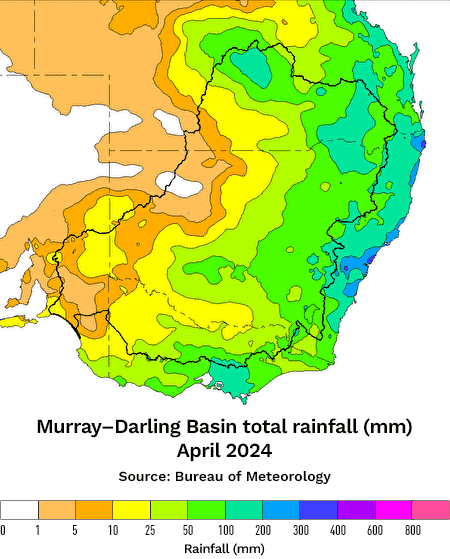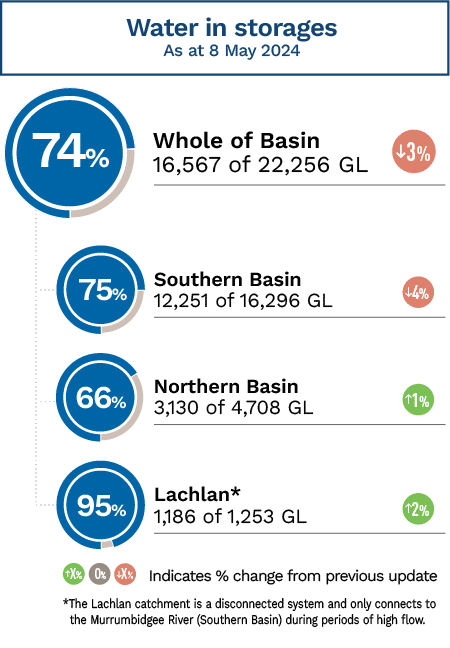- Mixed rainfall across the southern and northern Basin
- Long-range forecast into June predicts below average rainfall is likely to very likely
- The likelihood of water quality issues typically reduces with the onset of cooler conditions
- Conditions across the Basin remain favourable for blue-green algae outbreaks.

Drought
A trend in dry conditions continues throughout the Basin, as predicted in the State of the Climate 2022 report. These conditions are largely evident in the south-east of Australia and are expected to continue during the cool season months of April to October.
By looking at the deficiencies for the 16 months since December 2022, it is evident that isolated pockets of deficiencies are most concentrated in the most southern part of the lower Murray catchment. If we then look at the 9 months since August 2023, it can be confirmed that these isolated areas of deficiencies have now expanded and intensified.
In April, root zone soil moisture increased over south-east Queensland, New South Wales, and western and central Victoria following high rainfall. However, low rainfall in South Australia resulted in very much below average soil moisture expanding into the south of the state.

Rainfall
In April, the national rainfall was 26% below the 1961 to 1990 average. Despite this, rainfall was still generally high across the northern Basin, with the eastern catchments recording above average to very much above average rainfall. The picture in the southern Basin was significantly drier, with the more central catchments receiving average to below average rainfall for the month of April.
In the northern Basin it was Warialda in the Gwydir catchment that topped the chart for rainfall, receiving more than 212 mm.
Highest rainfall for the southern Basin was recorded in Tabilk, more than 60 kilometres south of Shepparton in the Goulburn–Broken catchment.
Scattered areas of the southern Basin were significantly drier than the rest of the system, with some locations recording less than 1mm for the month of April.

Water storages and streamflow
As of 24 April 2024, total storage in the Basin was 16,673 GL (75%), which is a 2% decrease from March. Northern Basin storages increased by 1%, the Lachlan catchment by 2%, while southern Basin storages decreased by 3%.
This autumn has been drier with lower tributary inflows. In addition, water is being conserved in upper storages by reducing releases as irrigation demands are winding down. This will support future allocations.
Releases at Dartmouth Reservoir continue above the minimum to help balance the risk of spill between Dartmouth and Hume Dams while responding to demand downstream of Hume.
Downstream on the Kolety, diversions into Yallakool and Colligen Creeks are expected to increase in the coming weeks. These diversions help improve the condition of native fish populations by improving water quality, productivity and providing opportunities for dispersal.
On the Darling (Baaka), additional water for the environment continues to be delivered to support water quality outcomes upstream of Weir 32.
The Lake Victoria (Tar-Ru) storage volume is being managed in accordance with the Lake Victoria Operating Strategy (LVOS) as specified in the Objectives and Outcomes for River Operations in the River Murray System. It is expected that by the end of May there will be no need to transfer additional water to Tar-Ru, and the MDBA does not anticipate calling any additional water from the Menindee Lakes for the remainder of the water year.
Climate outlook
The Bureau’s long-range forecast indicates that for April to June rainfall is likely to very likely (60% to greater than 80% chance) to be below median for most of Australia.
Similarly, above median maximum temperatures are also likely to very likely (60% to greater than 80% chance) for almost all of Australia.
The long-range forecast is influenced by several factors, including El Niño nearing its end and highest on record global sea surface temperatures.

Water quality
The likelihood of water quality issues reduces with the onset of cooler conditions. However, Basin rivers and storages remain nutrient rich with conditions favourable for blue-green algae.
Summary of key water quality issues
- Low dissolved oxygen: The likelihood of water quality issues typically reduces with the onset of cooler conditions. However, Basin rivers and storages remain nutrient rich with conditions favourable for blue-green algae.
- Blue-green algae: There remains a risk of blue-green algae across much of the Basin, particularly in New South Wales and Victoria. An advisory notice for blue-green algae is currently in place for Lake Alexandrina in South Australia. For the latest alerts information, contact the respective state government via the ‘Getting information about current algal blooms’ page of our website.
- Elevated Salinity: Parts of the Menindee Lakes and the lower Darling (Baaka) River continue to see elevated salinity levels.
Water quality in the Basin is monitored by individual Basin state governments. Specific water quality alerts and advisories are issued by respective states.
You can find all the latest news in our Newsroom or by following our socials: Facebook, X (Twitter), LinkedIn.